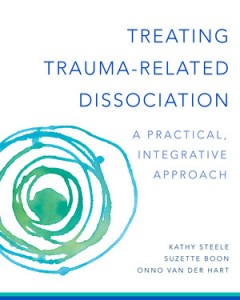
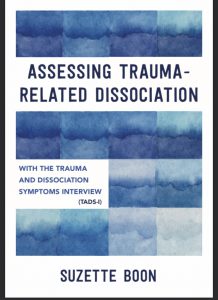 Assessment of Trauma-Related Dissociation – Introducing the Trauma and Dissociation Symptoms Interview. To be published by Norton publishers New York.
Assessment of Trauma-Related Dissociation – Introducing the Trauma and Dissociation Symptoms Interview. To be published by Norton publishers New York.
Trauma-related dissociative disorders are increasingly being considered in therapeutic practice and the clinical literature. On the one hand, dissociative disorders are still too often overlooked, on the other hand, they are also diagnosed more frequently when not actually present. This book elaborates on the assessment of these disorders, using the diagnostic instrument, the Trauma and Dissociation Symptoms Interview (TADS-I ) developed by me over the past decades.
I first address the dilemmas regarding the diagnostic criteria of dissociative disorders in the DSM-5 and ICD-11. I describe what dissociative symptoms actually are and how a clinician can recognize these symptoms and differentiate form other alterations of consciousness.
Several thematic chapters discuss key differential diagnostic considerations and illustrate them with case reports. Also discussed are the occurrence of false-negative and false-positive diagnoses of trauma-related dissociative disorders, the assessment of traumatic experiences and the development of a treatment plan.
This book is first and foremost intended for clinicians (psychiatrists, clinical psychologists, psychotherapists and nursing specialists) who want to (learn to) diagnose dissociative disorders. For colleagues who do not perform the assessment of dissociative disorders, it provides a lot of information aimed to assist clinicians to better recognize patients with dissociative symptoms and to refer them for specialized diagnostic testing.
The complete TADS-I diagnostic tool is included in the book and available for download.
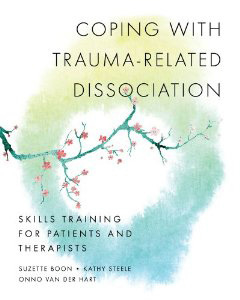 A patient-oriented manual for complex trauma survivors.
A patient-oriented manual for complex trauma survivors.
This training manual for patients who have a trauma-related dissociative disorder includes short educational pieces, homework sheets, and exercises that address ways in which dissociation interferes with essential emotional and life skills, and support inner communication and collaboration with dissociative parts of the personality. Topics include understanding dissociation and PTSD, using inner reflection, emotion regulation, coping with dissociative problems related to triggers and traumatic memories, resolving sleep problems related to dissociation, coping with relational difficulties, and help with many other difficulties with daily life. The manual can be used in individual therapy or structured groups.
There is also a Polish (Jagiellonian University Press), Turkish (Psikonet Yayincilik ve Egitim A.S.) and Chinese (Babel Books) translation available.
 |
 |
 |
 |
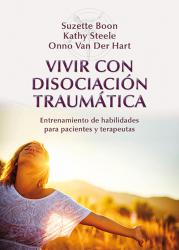 |
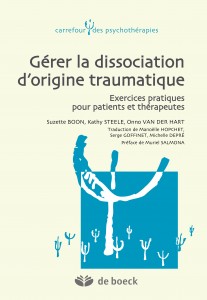 |
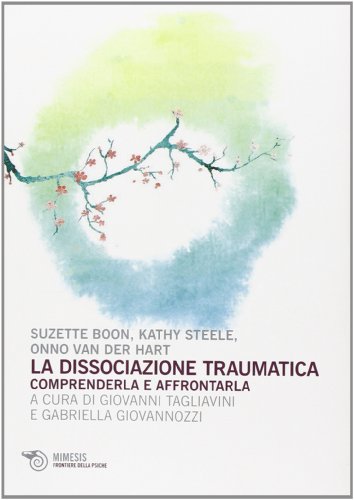 |
| Dutch Click here to buy |
German Click here to buy |
Swedish Click here to buy |
Finnish Click here to buy |
Spanish Click here to buy |
French Click here to buy |
Italian Click here to buy |
Treating trauma-related dissociation
The book offers an overview of the neuropsychology of dissociation as a disorder of non-realization, as well as chapters on assessment, prognosis, case formulation, treatment planning, and treatment phases and goals, based on best practices. The authors describe what to focus on first in a complex therapy, and how to do it; how to help patients establish both internal and external safety without rescuing; how to work systematically with dissociative parts of a patient in ways that facilitate integration rather than further dissociation; how to set and maintain helpful boundaries; specific ways to stay focused on process instead of content; how to deal compassionately and effectively with disorganized attachment and dependency on the therapist; how to help patients integrate traumatic memories; what to do when the patient is enraged, chronically ashamed, avoidant, or unable to trust the therapist; and how to compassionately understand and work with resistances as a co-creation of both patient and therapist. Click here to buy
Translations in Dutch, Spanish, French, German, Italian and Finnish.
Warmly recommended:
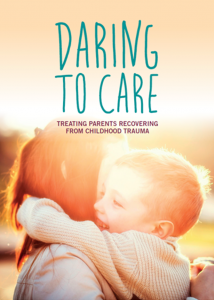 Daring to Care model is a group intervention developed to target specifically trauma-symptoms of parents surviving from childhood abuse. Its goal is to prevent intergenerational harmful effects of traumatization by helping parents understand their trauma-related difficulties and find better ways to regulate and cope with them. Daring to Care is designed as an add-on to individual psychotherapeutic treatment. The model consists of 24 topics presented over the course of 30 sessions, each with its own set of exercises and assignments to encourage individual experiential reflection. The Daring to Care intervention can be used for parents with different traumatic experiences in their early care-taking relationships, varying trauma symptoms, and children of different ages from birth to 18 years. The Daring to Care model has been developed to address some of the specific difficulties that traumatized parents struggle with, in order to help them break the intergenerational chain of maltreatment and neglect. More info
Daring to Care model is a group intervention developed to target specifically trauma-symptoms of parents surviving from childhood abuse. Its goal is to prevent intergenerational harmful effects of traumatization by helping parents understand their trauma-related difficulties and find better ways to regulate and cope with them. Daring to Care is designed as an add-on to individual psychotherapeutic treatment. The model consists of 24 topics presented over the course of 30 sessions, each with its own set of exercises and assignments to encourage individual experiential reflection. The Daring to Care intervention can be used for parents with different traumatic experiences in their early care-taking relationships, varying trauma symptoms, and children of different ages from birth to 18 years. The Daring to Care model has been developed to address some of the specific difficulties that traumatized parents struggle with, in order to help them break the intergenerational chain of maltreatment and neglect. More info
In English
Boon, S. (1997). The treatment of traumatic memories in DID: Indications and contraindications. Dissociation. Vol.X, No.2, 65-79.
Boon, S. & Draijer, N. (1991). Diagnosing Dissociative Disorders in the Netherlands. A pilot study with the Structured Clinical Interview for DSM-III-R dissociative Disorders. American Journal of Psychiatry, 148, 458- 462.
Boon, S. & Draijer, N. (1993a). Multiple Personality Disorder in the Netherlands. A clinical investigation of 71 patients, American Journal of Psychiatry, 150 (1993a) 3: 489-494
Boon, S. & Draijer, N. (1993b). Multiple Personality Disorder in the Netherlands. (Amsterdam: Swets & Zeitlinger, 1993b) (Dissertation, 1993b)
Boon, S. & Draijer, N. (1993c). The Differentiation of Patients with MPD or DDNOS from patients with a cluster B Personality Disorder”, Dissociation, 6, 2/3, 126-135.
Boon, S. & Steele, K. (2011). Skills-Based Structured Group Treatment for Patients with Complex Dissociative Disorders: an Overview of a new Therapeutic approach. In: ESTD Newsletter, 1(2) pp 6-9.
Boon, S. Steele, K & Hart, O. van der (2011). Coping with Trauma-Related Dissociation: Skills Training for Patients and Therapists. New York: Norton (Current translations in Finnish, Swedish, Dutch, German; Norwegian, French and Italian translations are forthcoming)
Draijer, N. & Boon, S. (1993). The validation of the Dissociative Experience Scale against the criterion of the SCID-D, using Receiver Operating Characteristics (ROC) analysis. Dissociation. Vol. VI, No.1, pp. 28-37
Draijer, N. & Boon, S. (1999). The Imitation of Dissociative Identity Disorder. Patients at risk; therapists at risk. The Journal of Psychiatry and Law, 27, fall-winter, 423-458.
Hart, O. van der, Boon, S., & Everdingen, G.A. van (1990). Writing assignments and hypnosis in the treatment of traumatic memories. In: M.L. Fast & D.P. Brown (Eds.), Creative mastery in hypnosis and hypnoanalysis: A Festschrift for Erika Fromm (pp. 231-253). Hillsdale, NJ: L. Erlbaum Associates.
Hart, O. van der & Boon, S. (1997). Treatment strategies for complex dissociative disorders: Two Dutch case examples. Dissociation, 9(3), 157-165.
Hart, O. van der, Boon, S. & Heijtmajer Jansen, O. (1997). Ritual abuse in European countries: A clinician’s perspective. In G.A. Fraser (Ed.), The dilemma of ritual abuse: Cautions and guides for therapists (pp. 137-163). Washington, DC: American Psychiatric Press
Hart, O. van der, Steele, K., Boon, S., und Brown, P. (1993). The treatment of traumatic memories: Synthesis, Realization and Integration. Dissociation, 6, 162-180
Hart, O. van der, Kolk, B.A. van der & Boon, S. (1998). Treatment of dissociative disorders. In J.D. Bremner & C.R. Marmar (Red.), Trauma, memory, and dissociation (pp. 253-283). Washington, DC: American Psychiatric Press.
In French and German
Hart, O. van der & Boon, S. (1993). Le Traitement du désordre de la personnalité multiple. Annales Médico-Psychologiques: 1993, 151, no. 8.
Hart, O. van der, Steele, K., Boon, S. & Brown, P. (1995). Die Behandlung traumatischer Erinnerungen: Synthese, Bewußtwerdung und Integration Hypnose und Kognition: Band 12, Heft 2, October 1995
In Dutch
S. Boon & O. van der Hart (2018). Dissociatieve stoornissen in: E. Simon e.a [red] klinische psychologie. diagnostiek en behandeling. Groningen/ Utrecht. Noordhoff Uitgevers pp. 239-252
S. Boon & O. van der Hart (2017) . Diagnostiek van dissociatieve stoornissen. in: A. Driessen en W. Langeland [red] Praktijkboek Psychotrauma. Amsterdam: b.v. Uitgeverij SWP pp. 57-71
Boon, S. (2003, 2008). Directieve en hypnotherapeutische interventies als onderdeel van een fasengerichte behandeling van vroeger seksueel misbruik. In: Nicolaï, N (Red.) Handboek Psychotherapie na seksueel misbruik (pp. 201-215), Utrecht, de Tijdstroom
Boon, S. (2012). De Behandeling van Complexe Dissociatieve stoornissen. In: van Lichtenburg, C. (2012) Wat als ik .. wij zijn. (pp. 108-138). Leiden. De Witte Uitgeverij.
Boon, S. (2013). Behandeling van cliënten die (ritueel) misbruik door georganiseerde dadernetwerken rapporteren. Reflectie op bijna dertig jaar ervaring. Tijdschrift voor Psychotherapie, 39, 6 pp 441-452
Boon, S. & Draijer, N. (1995a). Screening en diagnostiek van dissociatieve stoornissen. Lisse/Amsterdam Swets & Zeitlinger (Screening and diagnosis of dissociative disorders)
Boon, S. & Draijer, N. (1995b). Comorbiditeit bij de Dissociatieve Identiteitsstoornis In: C.A.L.Hoogduin et.al (Red.). Jaarboek voor Psychiatrie en Psychotherapie (pp 103-115) Houten: Bohn Stafleu Van Loghum.
Boon, S. & Draijer, N. (2007). Diagnostiek van dissociatieve stoornissen met de SCID-D: mogelijkheden en beperkingen Psychopraxis, 9, 27-32
Boon, S. & Draijer, N. (2012). Dissociatieve Stoornissen In T. Ingenhoven et al (Red.): Handboek Borderline Persoonlijkheidsstoornis. (pp329-341). Utrecht: De Tijdstroom
Boon, S. & Hart, O. van der (1988a). Dissocieren als overlevingsstrategie bij fysiek en seksueel geweld. Trauma en Dissociatie I. Maandblad Geestelijke Volksgezondheid 43, 1197-1207
Boon, S. & Hart, O. van der (1988b).Het herkennen van dissociatieve stoornissen in het bijzonder de multiple persoonlijkheidsstoornis. Maandblad Geestelijke Volksgezondheid 43, 1208-1225
Boon, S. & Hart, O. van der (1989).De Behandeling van de multiple persoonlijkheidsstoornis. Maandblad Geestelijke Volksgezondheid, 44, 1283-1299
Boon, S. & Hart, O. van der (1991). De behandeling van de multiple persoonlijkheidsstoornis. In Hart, O. van der (Red.), Trauma, dissociatie en hypnose (pp. 159-187). Lisse: Swets & Zeitlinger.
Boon, S. & Hart, O. van der (1994). De meervoudige persoonlijkheidsstoornis: Diagnostiek en behandeling. De Psycholoog, 29(11), 423-428.
Boon, S. & Hart, O. van der (1995). De behandeling van de dissociatieve identiteitsstoornis In: Hart, O. van der (Red.), Trauma, dissociatie en hypnose, 3e druk (pp. 187-232). Lisse: Swets & Zeitlinger.
Boon, S. & Hart, O. van der (1996). Stabilisatie en symptoomreductie in de behandeling van patiënten met een dissociatieve identiteitsstoornis. Tijdschrift voor Psychiatrie, 38(2), 159-172.
Boon, S., Steele, K. & Hart, O. van der (2012) . Omgaan met trauma gerelateerde dissociatie: een vaardigheidstraining voor patienten en hun therapeuten. Amsterdam: Pearson
Draijer, N. & Boon, S. (1996). Knelpunten in de differentiële diagnostiek van de dissociatieve identiteitsstoornis. Tijdschrift voor Psychiatrie, 2, 38, pp. 108 – 122
Draijer, N., Langeland, W., & Boon, S.(2012a. Klinische diagnostiek van complexe traumagerelateerde stoornissen. In E. Vermetten et al (Red.). Handboek Postttraumatische Stressstoornissen (pp491-510). Utrecht: de Tijdstroom
Draijer, N., Langeland, W., & Boon, S.(2012b). Complexe traumagerelateerde stoornissen na vroegkinderlijke traumatisering. In E. Vermetten et al (Red.). Handboek Postttraumatische Stressstoornissen (pp 619-638). Utrecht: de Tijdstroom
Hart, O. van der & Boon, S. (1990). Hypnose bij multipele persoonlijkheidsstoornis. In C.A.L. Hoogduin et al. (Red.), Jaarboek voor psychiatrie en psychotherapie (pp. 164-174). Houten: Bohn Stafleu Van Loghum.
Hart, O. van der & Boon, S. (1991). Dissociatieve stoornissen: Een model voor de behandeling van multipele persoonlijkheidsstoornis. In: R. van Dyck et al. (Red.), Hypnose en hypnotherapie (pp. 263-276). Houten: Bohn, Stafleu, Van Loghum.
Hart, O. van der & Boon, S. (1991). Schrijfopdrachten en hypnose in de behandeling van traumatische herinneringen. In: Hart, O. van der (Red.), Trauma, dissociatie en hypnose (pp. 189-218). Lisse: Swets & Zeitlinger.
Hart, O. van der & Boon, S. (1991).Mutiple Persoonlijkheidsstoornis bij kinderen. In W.H.G. Wolters Psychotrauma’s bij jongeren (pp47-70). Baarn: Ambo
Hart, O. van der & Boon, S. (1993a). De behandeling van traumatische herinneringen bij de multiple persoonlijkheidsstoornis. Directieve therapie, 13(2), 114-160.
Hart, O. van der & Boon, S. (1996). Dissociatieve stoornissen. In W. Vandereycken, C.A.L. Hoogduin & P.M.G. Emmelkamp (Red..), Handboek psychopathologie, deel III (pp. 126-144). Houten: Bohn Stafleu Van Loghum.
Hart, O. van der, Boon, S., Friedman, B., & Mierop, V. (1992). De reactivering van traumatische herinneringen. Dth, 12(1), 12-55.
Hart, O. van der & Boon S. (2001). De behandeling van de dissociatieve stoornissen In: R.E Abraham & J.Graste (Red.). Psychotherapie vanuit het deficit model (pp 43-64). Assen: Koninklijke van Gorcum B.V


